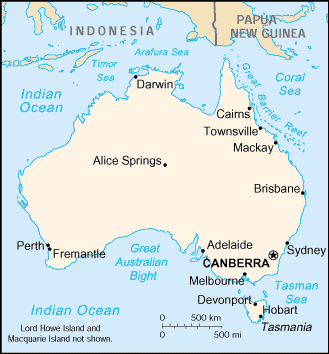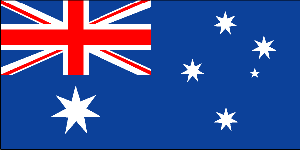
|
Australia
Background:
Australia became a commonwealth of the British Empire in 1901. It was able
to
take advantage of its natural resources to rapidly develop its
agricultural and
manufacturing industries and to make a major
contribution to the British effort
in World Wars I and II. Long-term
concerns include pollution, particularly
depletion of the ozone layer,
and management and conservation of coastal areas,
especially the Great
Barrier Reef. A referendum to change Australia's status,
from a
commonwealth headed by the British monarch to an independent
republic,
was defeated in 1999.
Location:
Oceania, continent between the Indian Ocean and the South Pacific
Ocean
Area: Total: 7,686,850 sq km water: 68,920 sq km note: includes Lord
Howe
Island and Macquarie Island land: 7,617,930 sq km
Area -
comparative: Slightly smaller than the US contiguous 48 states
Coastline: 25,760 km
Climate: Generally arid to semiarid;
temperate in south and east; tropical in
north
Climate and Terrain:
Terrain: Mostly low plateau with deserts; fertile plain in southeast
Elevation extremes: Lowest point: Lake Eyre -15 m highest point:
Mount
Kosciuszko 2,229 m
Natural resources: Bauxite, coal, iron
ore, copper, tin, silver, uranium,
nickel, tungsten, mineral sands, lead,
zinc, diamonds, natural gas, petroleum
Land use: Arable land: 7%
permanent crops: 0% other: 93% (1998 est.)
People:
Population: 19,546,792.
Ethnic groups: Caucasian 92%, Asian 7%,
aboriginal and other 1%.
Religions: Anglican 26.1%, Roman Catholic 26%,
other Christian 24.3%,
non-Christian 11%, other 12.6%.
Languages: English, native languages.
Government:
Government type: Democratic, federal-state system recognizing the
British
monarch as sovereign.
Capital: Canberra.
Independence: 1 January 1901 (federation of UK
colonies).
Economy overview:
Australia has a prosperous Western-style capitalist economy, with a per capita
GDP on par with the four dominant West European economies. The Australian
economy has been resilient in the face of the global economic downturn in 2001
chalking up 2.3% GDP growth, as the domestic economy is offsetting the external
slump and business and consumer confidence remains robust. Canberra's emphasis
on reforms is a key factor behind the economy's strength, and Australia is
expected to outperform its trading partners in 2002, with GDP growth projected
to be 3% or better.
GDP - composition by sector: Agriculture: 3% industry: 25% services: 72%
(2000 est.)
Statistics:
Telephones - main lines in use: 10.05 million.
Telephones - mobile
cellular: 8.6 million.
Radio broadcast stations: AM 262, FM 345.
Radios: 25.5 million.
Television broadcast stations: 104.
Televisions: 10.15 million.
Internet users: 10.06
million.
Railways: Total: 33,819 km.
Highways: Total: 913,000 km.
Airports: 421 (2001)
Airports - with paved runways: 282, with
unpaved runways: 139.
Return to Visiting Locations
|

